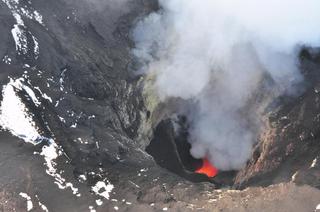Shishaldin Volcano Latest to Wake in Aleutians

Monday, November 24 2014
Another volcano in the Eastern Aleutian Islands has woken up, a week after a burst of activity at Pavlof Volcano.
Shishaldin Volcano is about 100 miles west of Pavlof, near False Pass. Scientists at the Alaska Volcano Observatory started seeing stronger tremors and hotter temperatures at the volcano early Monday morning.
But the AVO didn’t increase Shishaldin’s alert status, since it’s already on watch. Geophysicist Chris Waythomas says Shishaldin has been restless all year.
"It’s a very seismically active volcano, so there’s always something -- seismic tremors, small earthquakes, gas emissions, explosions. It’s always perking away," he says. "But it recently kind of went to a little higher level of unrest."
The biggest surprise, he says, is that it took this long for the volcano to ramp back up. Still, it’s not visibly erupting right now. Its summit crater is three or four times deeper than the one at Pavlof -- meaning Shishaldin needs stronger shaking before it starts throwing out material.
"Now, if the crater begins to fill up with lava, and a lot of gas moves into the system, this could trigger more of that kind of lava fountaining, emission of particles and stuff," Waythomas says.
Shishaldin’s been known to send up ash plumes well into the way of air travel - but it hasn’t done so in about five years. Its last major eruption was in 1999, when its plume was as high as 56,000 feet above sea level.
Pavlof, meanwhile, has been an obstacle for planes several times in the past couple of years. But it’s been quiet since its quick, intense eruption about a week ago.
Waythomas says there’s no connection between the two peaks waking up at the same time. They’re just located in the most volcanically active part of the Aleutian chain.
As Shishaldin’s unrest continues, the AVO hopes passing pilots will snap some photos of any lava or ash at the summit. The volcano is the tallest in the Aleutians, and it’s also perfect cone -- easily visible on flights from places like Unalaska up to Anchorage.



